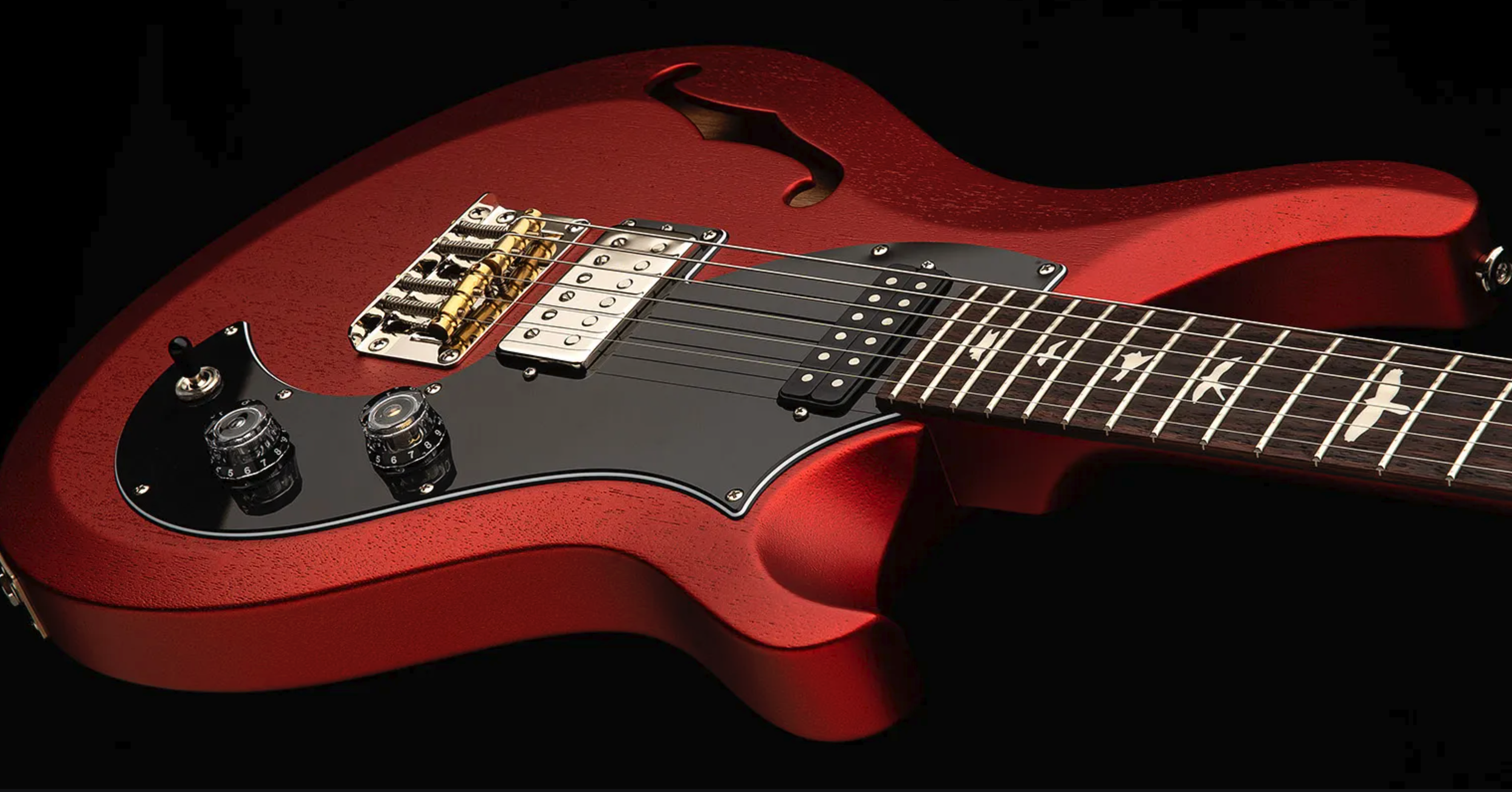Review : PRS S2 Vela Semi Hollow Satin
The S2 Vela Satin in Red Apple Metallic
In this review, I take a deep dive into another of the PRS S2 family, this time the S2 Vela Semi Hollow Satin.
So what makes the S2 Vela different from the S2 Standard that I recently reviewed? Fair question. The biggest difference visually is that the S2 Vela departs from the well known PRS body shape, into what I would call an offset version of that shape. As my friend Cody puts it, one of the hips is higher than the other. If that makes no sense, then you have not looked closely at the standard PRS shape closely.
Of course there are many other differences, but this one is the most obvious. The Semi Hollow version is much like other PRS Semi-Hollow body guitars with an emphasis on being light weight. I mean in mass, not in capability. I of course must acknowledge the support and greatness of The Arts Music Store for arranging an instrument for review. The version that I obtained is Pearl White in the satin finish. You really should shop there.
While it makes no difference to the sound or playability, I am not fond of open pored satin finishes
Let me get my feelings about the satin finish out of the way quickly. It is not for me. The body wood is not filled, and the satin finish has a slightly rough feel to it. Fortunately, for Vela buyers there is a high gloss nitro finish version of this guitar, as well as for the solid body Vela guitars. I chose a semi hollow because I wanted a sense of how much different it would be from the S2 Standard 24 that I thought and still think is the best USA made guitar for the bucks out there.
Overview
This is a mahogany body and neck guitar. I noticed how light it was when I picked it up. Folks with neck or back issues will love this for the minimal weight alone. It has two pickups, a DS-1 in the bridge and a Narrowfield in the neck. There is a 3 way pickup selector and a coil tap of the bridge humbucker is available for the bridge and the center position by pulling up on the tone control knob. It works as expected, although if it were up to me, I would go with the simpler five way blade found on the S2 Standard 24. The neck carve is a PRS Pattern Regular which is marginally thicker than the Pattern Thin on the S2 Standard 24. All the models in the Vela group have 22 frets. There is no vibrato, instead an interesting adaptation of a Telecaster style flat bridge plate with two long brass saddles set at angles for proper intonation. When I first saw this, it made me think of the saddles on Lowden acoustics which are renowned for their excellent intonation. The bridge plate is of a keyhole design, a different way of top loading strings. The tuners are non-locking and have the new last year “PRS Wing” knobs. They look pretty, but I would personally prefer locking tuners, but that is my personal preference. Fortunately for my preferences, the version I have for evaluation is a late 2024 with regular tuning knobs and the proven PRS locking tuners.
Did I mention that this guitar is lightweight? I set it beside my early 1970’s Les Paul and it feels about half the weight. The body is of course slimmer, and the beveled edges as found on all S2 family guitars further reduce weight while improving comfort especially when playing while seated.
Specifications
As I now always try to do, I just screen captured the information directly from the PRS web site for the 2025 model.
I am aware that some folks develop underwear entanglement when they see scarf joint. This is silly. First the glue joint of a scarf joint done well is actually stronger than a single piece of wood and second it means a lot less wasted wood on a neck blank.
The bridge plate is rather Tele like. The string ball ends lock into keyhole slots in the bridge plate and then cross the brass saddles with three strings per saddle. Each saddle has two intonation adjustment screws. The two saddle layout does work for good intonation. Is it better or worse than a Tele two string per saddle build? I really cannot tell a difference, although I would prefer one saddle per string if I was in charge of this.
The pickups are cleanly mounted and each delivers a unique tone, with the humbucker warm and strong and the neck narrowfield brighter, but not compromising in volume. I like this pairing a lot. As one would expect from this design, it’s noisefree into a clean amp with no op amps between the guitar and the amplifier.
Controls
The S2 Vela Semi-Hollow Satin has two pots and a three way switch. The tone pot is a push pul that taps (not splits) the bridge humbucker. Thus it remains noiseless and with only a minor volume drop. Because it only works on the bridge, there is never a tap on the neck which is single coil already, so the coil tap only works in the bridge or both pickup switch positions. The image has a typo for Position 3, it says coil tap switch up, but it is actually down as seen in the image graphic.
Colours
As I have said many times, the paint work done by PRS is exemplary, but I find the colour palette, to be polite, boring. The colours do look better live than in the colour chips from the PRS site. They are left to right Mavis Mint Metallica, Metallic Midnight (really a dark blue), Pearl White, and Candy Apple Red Metallic. All would look better on pore filled wood and with a high gloss top coat in my opinion. There is a gloss version of the guitar, offering the same colours as the S2 Standard 24.
I really wish that PRS would liven up their solid colours, perhaps stealing a paint colour chart from Chrysler / Dodge / Plymouth from the late nineteen sixties and early nineteen seventies. Those electric greens, oranges and purples would really make this instrument rock. My opinion only, and I grew up then when cars had options other than black, white, silver and (yuck) primer grey.
Playability
The S2 Vela Semi Hollow Satin plays wonderfully. The neck profile is superb, even for someone like myself with fingers more closely resembling sausages instead of spider legs. The controls are easy to access, and even the push pull is engageable without long fingernails on the playing hand. All the controls feel positive. My model is a late 2024 iteration and has the traditional tuners and locking posts, and I prefer that over the tuners on the 2025, regardless of how excited Mr. Smith gets about the wing shaped tuning knobs.
The guitar balances well on your lap or on a quality strap. The jack is on the edge of the lower rear bout, and so I recommend a 90 degree plug on your cable. I have noted earlier how lightweight the guitar is due to the lack of a heavy maple cap and that it is legitimately semi-hollow. I find that the acoustic resonance of the Vela is excellent and it is quite loud acoustically with a nice even tone. All the benefits of a semi-hollow without any of the downside of laminated tops.
I think that the pickups sound great. The DS-1 in the bridge is not as hot as the 85/15 LT pickups in the S2 Standard 24, and is also to my ear a bit warmer. I really like the Narrowfield in the neck because it can be warm without being muddy. I am a big fan of the Narrowfield pickups.
As I expect from PRS, the neck setup was perfect, with a tiny bit of bow, but not so much that picky me wanted to make an adjustment. The nut was cut perfectly, the intonation out of the box was excellent and the fretwork superb. No fret sprout, no fret level issues, truly ready to play.
Example Sounds
In order to provide you with some tonal variety, I recorded the PRS Vela Semi Hollow into my Universal Audio Dream ‘65 Reverb Amp and then direct into Logic Pro via a UA Apollo Twin X interface using low impedance inputs. I used two amp setups in the Dream, the one for the first three examples is a classic Deluxe Reverb clean tone with some reverb and the final is the Deluxe Reverb pushed into medium overdrive. All options use a 12” speaker, an Oxford for the first three and a D65 for the fourth.
Each track was individually post processed very gently, with some light compression (UA 1176AE) on the first. The second has a doubler and subtle tape delay. The third has slightly more aggressive tube compression (Fairchild 670) and a spatial expander (TC 1210). The fourth uses two separate instances of the TC2290, the first as a widener and the second for a very light delayed chorus. Mastering for all tracks used the Abbey Road Mastering Desk.
The first track just demonstrates the tones based on switch position from neck to middle to bridge for the first three. The last three are with the tone pot up which splits the humbucker. In this case there is no change in the tone of the neck only as expected. I think that you will find the split bridge very Tele-esque in its brightness.
The second track is simple single note run with both pickups, no split.
The third is the neck pickup alone, with the tone rolled off to 5, producing a nice warm tone for complex chords without making them muddy.
The fourth is the bridge pickup alone, no split. it crunches in the Deluxe very nicely but retains clarity in accordance with your pick attack.
Based on the variety of tonal options with the PRS Vela Semi Hollow, I find this to be a superb all around guitar that can suit many musical styles.
Wrapping Up
Would I buy an S2 Vela? If I did not already have several PRS Core Semi-Hollows, the answer is YES. I would choose the gloss version because that is my preference, but colour and gloss are subjective things. It sounds different into a clean amp than the S2 Standard 24 does and the neck profile being a bit thicker does not bother me and I actually found fretting those rarer jazz chords a tiny bit easier, with more neck to grab hold of. I also prefered the Narrowfield in the neck for clean warm tones such as for Jazz because the natural brightness balances well when rolling the tone off a bit and using a Wes Montgomery right hand style.
If you like what I do here for you, please become a supporter on Patreon. Your monthly contribution makes an enormous difference and helps me keep things going. To become a Patreon Patron, just click the link or the button below. Always feel comfortable to send in a question or to post a comment. I read them all and respond as appropriate. Thanks for your support of my work. I’m Ross Chevalier and I look forward to sharing with you again soon.








